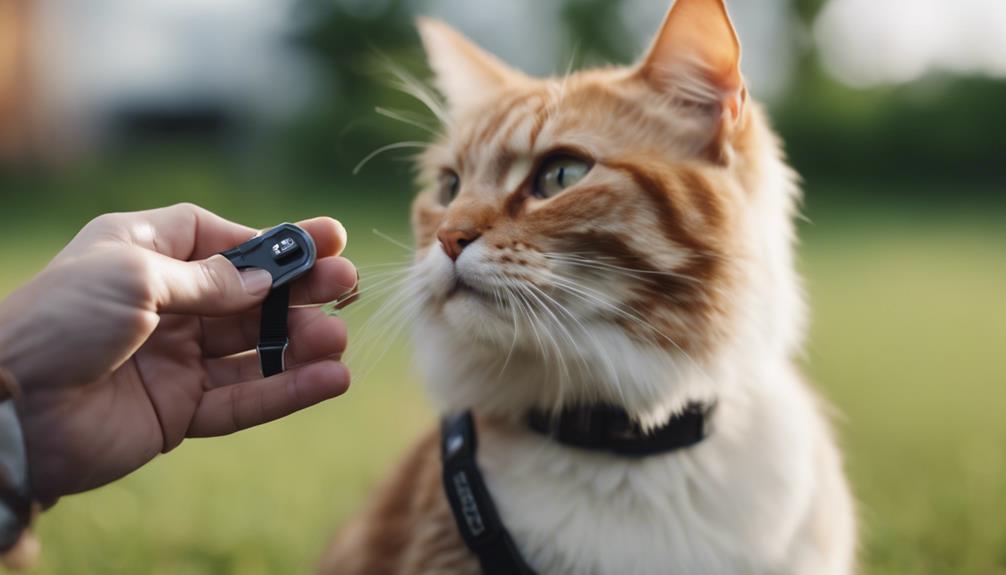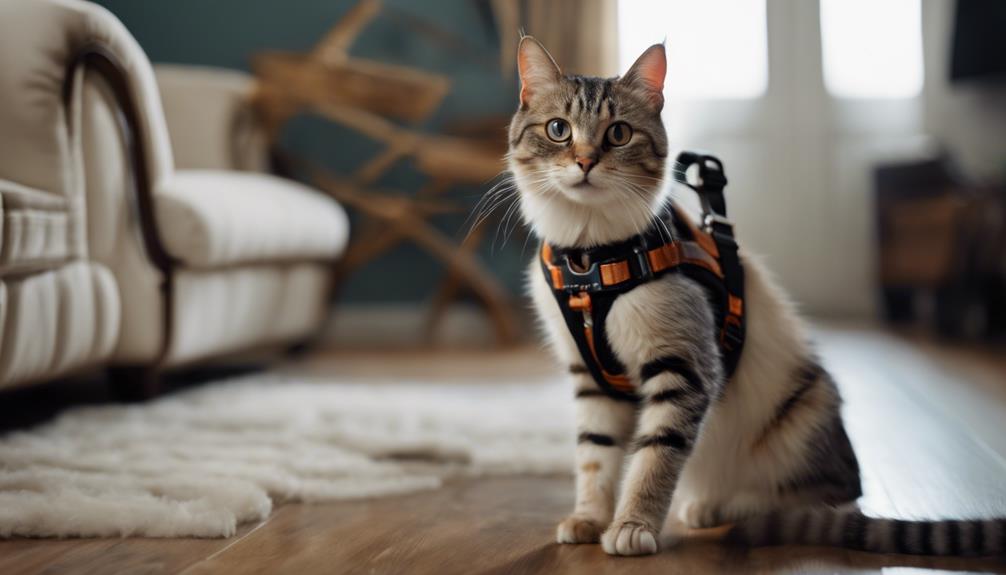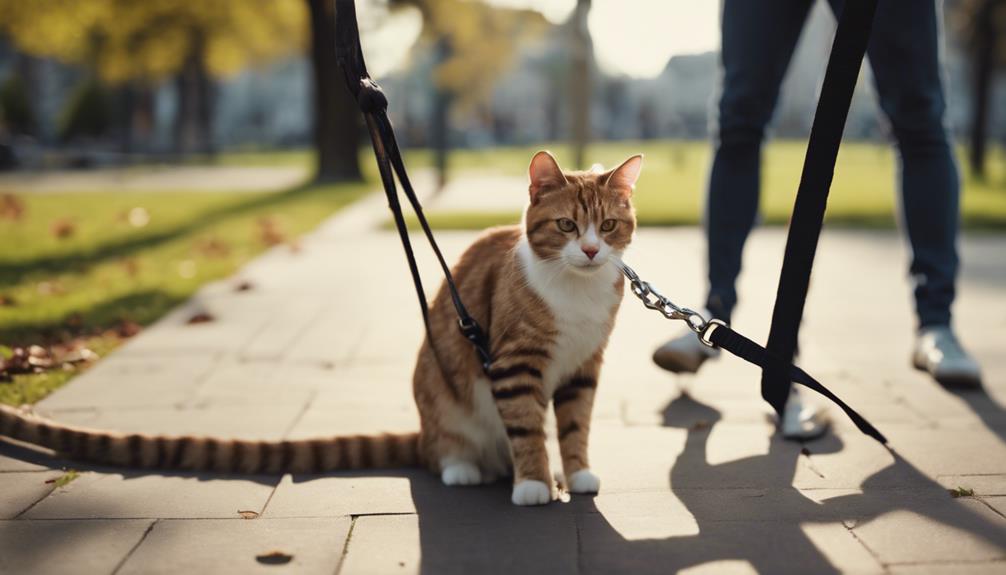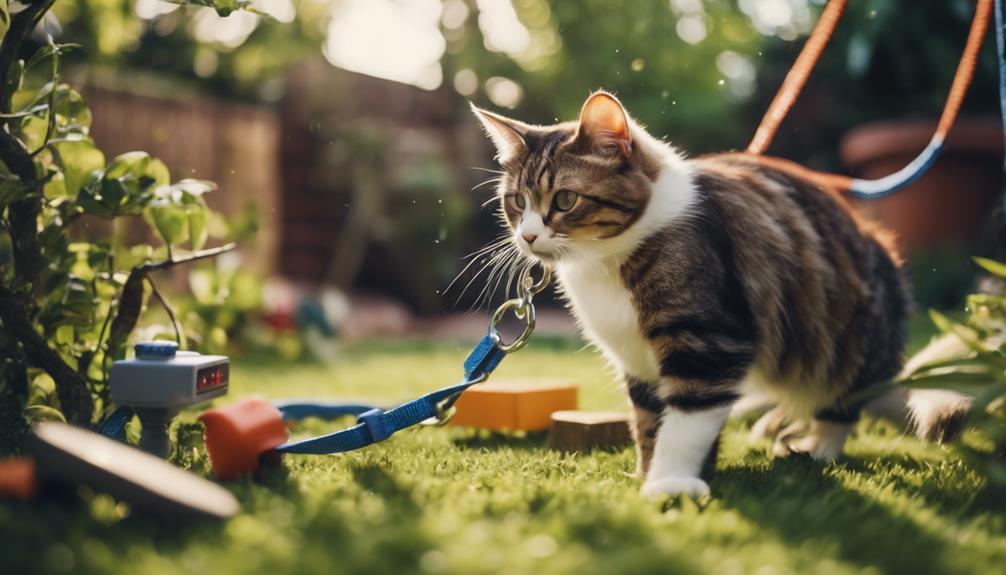Training a cat to walk on a leash and harness can be a rewarding endeavor for both the pet and owner. The process involves understanding feline behavior and implementing gradual steps to ensure a positive experience.
By establishing a strong foundation and utilizing effective techniques, cat owners can cultivate a harmonious relationship with their feline companions while exploring the great outdoors together.
As we delve into the intricacies of harness training for cats, we uncover valuable insights that can pave the way for a fulfilling journey of discovery and bonding between cat and owner.
Key Takeaways
- Start by introducing the harness gradually to ensure your cat's comfort.
- Use positive reinforcement and favorite treats to associate the harness with positive experiences.
- Practice walking indoors before venturing outdoors to teach your cat leash manners.
- Slowly increase the distance of outdoor walks in safe environments for successful leash training.
Harness Selection and Importance
When considering training a cat to walk on a leash, selecting the right harness is vital for ensuring comfort, safety, and security during outdoor excursions.
A suitable harness should fit snugly to prevent slipping but also allow for free movement. Opt for breathable materials to keep your feline companion cool and comfortable.
Harnesses provide a more secure option than collars, reducing the risk of escape during walks. Prioritize your cat's well-being by choosing a harness that they find comfortable and non-restrictive.
This step lays the foundation for successful leash training, ensuring that your cat is both physically and emotionally prepared for enjoyable outdoor adventures.
Gradual Harness Acclimation Process
How can cat owners effectively implement a gradual harness acclimation process for their feline companions? Gradually introducing a harness to your cat is crucial for their comfort and safety. Here is a structured approach to help your cat adjust to wearing a harness:
| Step | Description | Tips |
|---|---|---|
| 1 | Show the harness to your cat | Use treats to create a positive association |
| 2 | Allow your cat to sniff and explore the harness | Reward calm behavior with treats |
| 3 | Place the harness near your cat without putting it on | Gradually increase exposure time |
Outdoor Safety Measures for Cats

Implementing outdoor safety measures for cats is essential to protect your feline companions from potential risks in their environment. Before allowing your cat outdoors, ensure they are up-to-date on flea and tick preventatives, as well as essential vaccinations. Cats should also have proper identification, such as collars with tags or microchips, in case they wander off.
When outside, monitor your cat closely to prevent encounters with other animals, ingestion of toxic plants, or exposure to harmful substances. Provide a secure outdoor space for your cat to explore, such as a catio, to offer them the enrichment of the outdoors while keeping them safe.
Essential Preventatives for Outdoor Cats
To safeguard the health and well-being of outdoor cats, ensuring they are regularly administered preventatives is imperative. These essential preventatives help protect your feline companion from various health risks in the outdoors.
Here are some key preventatives to consider:
- Flea and tick medications
- Essential vaccinations
- Regular deworming treatments
- Tick collars for added protection
- Annual vet check-ups
Step 1: Teaching Marker Understanding

To ensure effective communication with your cat during training sessions, the initial step involves teaching your feline companion to understand a marker. A marker, often a clicker or a verbal cue like a short, distinct word, serves as a signal to your cat that they have performed the desired behavior correctly.
Start by pairing the marker with a treat consistently. When your cat hears the marker, immediately reward them with a treat. Repeat this process several times until your cat begins to associate the marker with receiving a reward. This step is crucial in laying the foundation for positive reinforcement training techniques that will be used throughout the leash training process.
Step 2: Positive Reinforcement Techniques
Utilizing positive reinforcement techniques is essential for encouraging desired behaviors in your cat during leash training sessions. Positive reinforcement involves rewarding your cat for exhibiting the behaviors you want to see more of. Here are some effective techniques to reinforce good behavior during leash training:
- Offer tasty treats as rewards
- Use verbal praise and gentle petting
- Utilize your cat's favorite toys as incentives
- Provide a comfortable and safe environment during training
- Be patient and consistent with your rewards
Step 3: Indoor Walking Practice

Engage your cat in indoor walking practice sessions to acclimate them to the harness and leash in a familiar and controlled environment. This step is crucial in preparing your cat for outdoor walks. Use treats and positive reinforcement to encourage your cat to walk comfortably with the harness on. Below is a table highlighting key points for successful indoor walking practice:
| Indoor Walking Practice Tips | ||
|---|---|---|
| Start Slowly | Use Treats | Be Patient |
| Practice in Quiet Spaces | Reward Good Behavior | Encourage Exploration |
| Use Short Sessions | Positive Reinforcement | Monitor Comfort Levels |
These tips will help your cat adjust to the harness and leash, setting the foundation for successful outdoor walks.
Step 4: Introducing Outdoor Walks
Initiate the transition from indoor practice to outdoor exploration by gradually introducing your cat to the outdoor environment while on a leash. This step is crucial in acclimating your cat to the sights, sounds, and smells of the great outdoors while ensuring their safety and security.
- Choose a quiet and familiar outdoor area for the first walk
- Let your cat lead the way and explore at their own pace
- Stay close by to provide reassurance and guidance
- Use positive reinforcement such as treats and praise
- End the walk if your cat becomes overwhelmed or anxious
Step 5: Increasing Outdoor Distance

To enhance your cat's outdoor walking experience, gradually extend the distance of your excursions while maintaining a focus on their comfort and safety. Start by increasing the outdoor distance in small increments, allowing your cat to acclimate to longer walks over time.
Observe your cat's behavior closely during these extended walks, ensuring they show signs of enjoyment and comfort. It's essential to pay attention to any cues of distress or fatigue and be prepared to shorten the walk if needed.
Harnessing Tips for Cat Owners
To further ensure the comfort and safety of your feline companion during outdoor walks, mastering proper harnessing techniques is paramount for cat owners.
- Choose the Right Fit: Opt for a harness that fits snugly but allows your cat to move comfortably.
- Introduce Gradually: Slowly acclimate your cat to wearing the harness, associating it with positive experiences.
- Check for Comfort: Regularly ensure the harness is not causing any discomfort or irritation to your cat.
- Secure Properly: Double-check that the harness is securely fastened before each outdoor excursion.
- Monitor Wear and Tear: Inspect the harness for any signs of wear and tear, replacing it if needed to maintain safety.
Further Resources and Cat Enrichment

Exploring additional resources and implementing cat enrichment practices can significantly enhance the overall well-being and mental stimulation of your feline companion. Enrichment activities such as puzzle feeders, interactive toys, vertical spaces, and window perches can provide mental and physical stimulation for your cat.
Websites like Catster and The Conscious Cat offer valuable insights into feline behavior, health, and enrichment. Additionally, considering books like 'Think Like a Cat: How to Raise a Well-Adjusted Cat – Not a Sour Puss' by Pam Johnson-Bennett can deepen your understanding of your cat's needs and behaviors.
Conclusion
In conclusion, the process of training a cat to walk on a leash and harness requires patience, consistency, and a deep understanding of feline behavior.
By implementing proper techniques and gradual exposure, cat owners can successfully acclimate their pets to the harness and leash, leading to enjoyable walks and bonding moments.
Through strategic steps and positive reinforcement, cats can learn to embrace the outdoors with confidence and enriching experiences, forging a stronger bond between feline and human companions.




